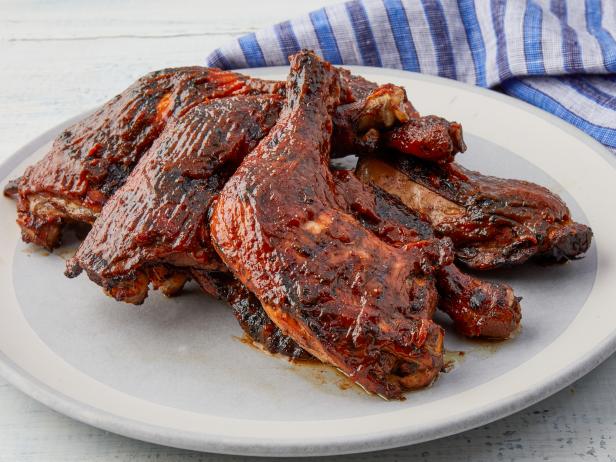You Don’t Need to Be Afraid to Cook a Cuisine That’s New to Your Kitchen
Take your cooking repertoire to places it’s never been before with these tips.


Sam Mellish/Getty
A few weeks ago, I set out on a quest to re-create a Jamaican meal I had only ordered at restaurants: beautifully seared, juicy jerk chicken, alongside hearty rice and peas, fried plantains and an ice-cold glass of tart-sweet sorrel (a spiced, hibiscus tea-based drink).
I’d watched Kwame Onwuachi’s Food Network Kitchen class on Jerk Chicken, and decided that I had to make it. And I refused to have my entrée without all my usual accompaniments — it just wouldn’t be the same eating jerk chicken with a side salad and water. If I was going to commit two days to making homemade jerk chicken, I was not going to skimp on the rest of the meal.
In a comically stern tone, I told my boyfriend on a Tuesday: "We are having a Caribbean feast on Thursday. Do not plan anything else."

Felicia Perretti
Similar to attempting a new recipe for the first time, I learned a lot on my journey cooking through a cuisine that was new to my kitchen — especially what to fine-tune the next time around. If you’re interested in expanding your recipe box and home cooking talents, choosing recipes from cuisines outside your usual wheelhouse exponentially increases your meal options. However, it will also bring on new challenges and potential frustrations while you’re in the process of familiarizing yourself with new techniques and flavors. Managing expectations is key. Here are a few tips to make the process a little smoother.
Have patience.
To gather all my ingredients, I visited three different grocery stores — a small Caribbean mart, an Indian specialty store and Whole Foods. It required some Google Map searches on the fly — and patience. Chances are, you’re accustomed to shopping at one local grocery store which may not carry everything you need to make a recipe sans substitutions. Use this as an opportunity to explore other retailers you may not have considered. You may find ingredients that become new pantry staples along the way.
Don’t be shy. Ask for help.
When shopping for rice and peas ingredients, I had trouble finding creamed coconut. I went up and down multiple aisles, assuming it would be in a can, where coconut milk would be. After feeling defeated, in the checkout line, I asked the cashier about it. They did have it stocked — but I’d been looking in the wrong place. She led me to the refrigerated dairy section, and there it was.
When looking for ingredients you’ve never seen or used, you’ll save yourself time and energy, just by asking.

Teri Lyn Fisher
Jet Tila's Drunken Noodles
Prepare for a higher-than-average receipt.
Depending on the dish, you may have to buy more pantry items than you would on a more routine grocery run. Keep in mind that when you normally shop, you often already have staples like olive oil or ketchup at home.
Again, this is an opportunity for kitchen expansion. You’re building your pantry staples for more amazing dishes. When you make a few more rounds of, say, Drunken Noodles, you won’t need to account for the oyster and fish sauce you’re buying now because you’ll have it already — right next to the EVOO.
Expect an upcharge if you buy ingredients online.
If local stores just don’t have the ingredients you need, the internet is a treasure trove. But know that many items online will be more expensive than they would be in-store. For instance, I’ve been able to get a jar of pork floss at my local Chinese grocery store for less than $5. But online, I’ve seen it go for several times its standard price.
Don’t let this discourage you, though. If a price seems unreasonable, shop around; prices vary among distributors.
Determine if you’ll need special equipment — or if you can easily create a makeshift tool.
Some recipes require special equipment — a wok, a deep-fry thermometer, a rolling pin — but oftentimes, you can make do with what you have. In a pinch, a cast-iron skillet can sub in for a wok since both pans can get really hot and hold that heat. A candy thermometer can replace a deep-fry one. And if you don’t have a rolling pin, there’s nothing wrong with a wine bottle.
You can always invest in a tool later — especially if you want to make the dish again. Don’t let lack of equipment deter you from a good meal.
Don’t bite off more than you can chew.
As delicious as it was to make a Jamaican spread, I was a bit in over my head trying to learn four new recipes in one night. The experience was … chaotic. Exhausted, we ate two and a half hours later than we planned — barely able to bring each recipe to completion.
My advice? Make one or two new recipes per meal. You’ll be happier you did and end up with better-executed dishes because you’ll have more time to focus on them.
Read. The. Entire. Recipe. Ahead. Of. Time.
I’m embarrassed to work at Food Network and have done this, but no, I did not read every word of every recipe before cooking. As a result: I sipped on lukewarm sorrel and was scrambling to hydrate dried beans that should have been soaking 24 hours prior. And if you’re planning to cook plantains? Plan to wait at least one to two weeks for them to ripen.
Read recipes before you even start shopping so you can anticipate all the prep work needed to bring a meal together.
Research how a dish is typically served.
When cooking a dish that’s foreign to you, do your homework. Where does it originate from? Is it usually eaten with hands or utensils? How is it traditionally served? If you’re serving a dish to your family or roommates, you, as the cook, will naturally serve as the point-person for all meal questions.
How you serve a meal is, of course, ultimately up to you, but being able to contextualize the food you make is all part of becoming a more knowledgeable cook and global citizen. Respect the cultures that inspire you by learning the basics.
Have fun!
It might feel like a lot to learn. But cooking different cuisines in your kitchen can be both challenging and exhilarating. Don’t get caught up in making everything perfect — it doesn’t have to be. You’re already learning so much about a cuisine (and culture) just by cooking it. And in no time, after trying (and sometimes failing) a few times, you’ll regularly make dishes that once felt out of reach.
Related Content:

































